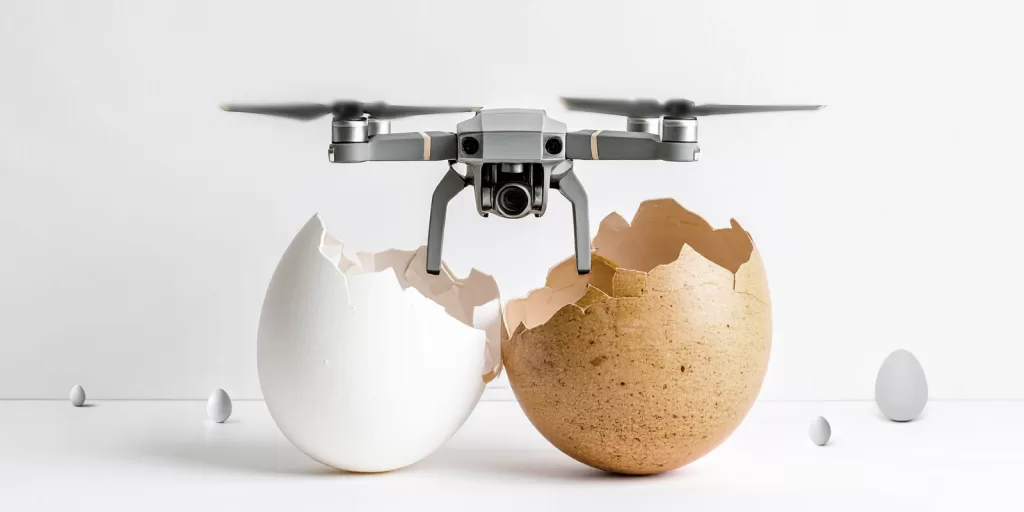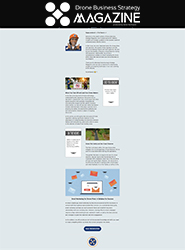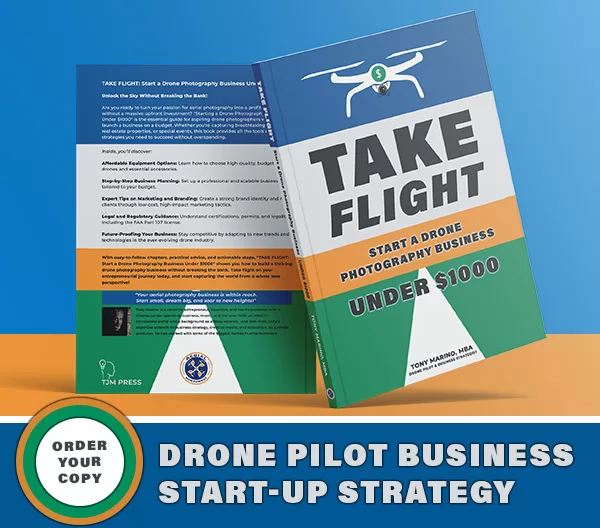
If you want your drone business to stay relevant, scalable, and profitable in the next 2–5 years, you need to understand where the industry is truly headed. This article breaks down the major shifts in technology, regulation, and infrastructure that will separate thriving aerial agencies from the ones that get left behind. It’s not just about flying anymore—it’s about positioning.
This insight comes from my own work as a drone business strategist, combined with reflections and lessons drawn from Erik Mintz‘s compelling series, “Decoding the Drone Industry” published on Commercial UAV News. Mintz does an excellent job unpacking the current and future direction of the drone sector, and I’ve layered those insights with my own research and field experience to give today’s commercial drone pilots a roadmap they can act on.
Drones Are Becoming Computers in the Sky
We’re moving beyond the idea of drones as flying cameras. That mindset is outdated and limits the full potential of what drones can offer. The future of drones is more like modular, flying computers—capable of adapting to specific tasks by integrating advanced software, interchangeable payloads, edge computing, and AI-driven analytics. Just like a laptop or smartphone, drones are evolving into smart platforms that process, interpret, and deliver actionable insights—not just collect visuals. This shift opens the door for drone pilots to become data solution providers instead of just content creators, dramatically increasing their value to industries like construction, agriculture, energy, real estate, and emergency services.
This shift means:
- Software is just as important as hardware
- Upgradable sensors and payloads give you flexibility
- Data processing is where real value is created
If your business still relies only on capturing photos or videos, you may get left behind. While visual content will always have its place, the real value in today’s drone industry lies in data-driven problem solving. Smart drone businesses aren’t just handing over media—they’re delivering insights. They’re using advanced sensors, thermal imaging, LiDAR, and analytics tools to **collect, process, and interpret data** that helps clients make faster, smarter decisions.
This evolution changes the role of the drone pilot from a camera operator to a data solutions provider. Whether it’s identifying heat loss in a building, calculating crop health, or analyzing structural defects, the clients who pay well aren’t looking for footage—they’re looking for outcomes.
Erik Mintz makes this point crystal clear: drones should no longer be seen simply as flying vehicles, but as mobile data platforms. This shift in mindset is foundational to modern drone business strategy. The pilots who embrace it will become essential partners across industries, while those who cling to “just flying” risk becoming obsolete.
The Power of a Clear Category
Clients don’t want to guess what you do. If your marketing says, “We do everything with drones,” you’re not helping them understand your value—you’re creating confusion. Vague messaging forces potential clients to work harder to figure out how you fit into their needs, and most won’t bother. In today’s competitive landscape, clarity is currency. Clients are looking for experts who specialize in solving their specific problems. When you clearly define your niche—whether it’s roof inspections, thermal imaging for utilities, or cinematic aerial footage for tourism—you immediately become more credible and easier to hire. Specialization builds trust, attracts higher-paying clients, and positions you as the go-to provider in your category.
Instead:
- Define your niche clearly: “We specialize in roof inspections for insurance adjusters.”
- Use industry-standard terms so you match what clients are searching for
- Focus on solving a specific problem better than anyone else
This is called category creation—the process of clearly defining what you do and who you do it for, in a way that makes your value obvious. When people instantly understand the category you own—whether it’s “roof inspections for insurers,” “thermal scans for solar farms,” or “construction progress tracking”—they trust you faster, refer you more often, and are willing to pay a premium. Clarity reduces friction in the sales process and sets you apart from generalists.
Erik Mintz highlights this idea as essential to commercial success. In an industry that’s rapidly diversifying, drone pilots can’t afford to be vague or try to be everything to everyone. If you want to grow, you have to name your lane—and then dominate it. Own your space, build authority around it, and let your category become the magnet that draws the right clients to your business.
Plug Into the Ecosystem
Drones don’t work alone. They succeed as part of a growing system—an interconnected ecosystem of technology, regulation, and infrastructure. From Uncrewed Traffic Management (UTM) systems to Beyond Visual Line of Sight (BVLOS) protocols, from real-time data platforms to automated landing hubs, drones rely on a network of support technologies to operate safely, efficiently, and at scale. As drone pilots, we’re not just flying—we’re plugging into a larger digital environment. The most forward-thinking drone businesses understand this and are actively building relationships with software developers, sensor manufacturers, cloud analytics providers, and even local municipalities. Success in this new era will come not from flying solo, but from knowing how to integrate and collaborate within the broader ecosystem.
They succeed as part of a growing system:
- UTM (Uncrewed Traffic Management)
- BVLOS (Beyond Visual Line of Sight) regulations
- Drone corridors and landing hubs
- AI and data analysis platforms
From my experience, the most scalable and future-ready drone businesses today are already building ecosystem partnerships. They understand that going it alone has limits. Instead, they’re teaming up with data analytics firms, software developers, AI platform providers, GIS experts, and industry-specific consultants to create turnkey solutions that deliver more than just drone footage—they deliver end-to-end results. These collaborations allow drone pilots to plug into larger client workflows, adding more value and unlocking bigger opportunities.
This is another key insight Erik Mintz unpacks in his series: the drone industry is no longer a stand-alone market—it’s becoming a connected environment. Pilots who understand where they fit into that broader system—whether in infrastructure, logistics, energy, agriculture, or construction—will gain a major competitive edge. When you position yourself as part of a complete solution, not just a vendor, you elevate your role and become essential to long-term client success.
Regulation is Speeding Up
Old aviation rules were slow and complex—designed for manned aircraft in rigid, highly regulated environments. But the pace of drone innovation has forced regulators to rethink their approach. Today, drone regulation is changing fast. Governments and aviation authorities are introducing “sandbox” environments, pilot programs, and rapid testing frameworks that allow drone operators to test new technologies and workflows in controlled, low-risk settings. This agile approach means the rules are being shaped as the technology evolves. If you wait until everything is finalized to adapt your business, you’ll be late to the party—and likely outpaced by competitors who’ve already built compliance into their operations. The smart play is to engage early, stay informed, and position your business to scale alongside evolving policy. Regulation is no longer just a hurdle—it’s becoming a growth lever for those who move with it.
Get involved now:
- Join local pilot networks or associations
- Stay informed on FAA and global updates
- Experiment with new workflows in pilot-friendly zones
Mintz and I both agree on this: compliance is no longer just a barrier—it’s becoming a growth channel. In the past, regulatory hurdles slowed drone adoption and limited opportunities. But today, that landscape is shifting. Governments are actively working with industry leaders to streamline approvals, create flexible testing environments, and develop standards that support innovation rather than block it.
For drone pilots, this creates a huge opportunity. Those who adapt early—learning new compliance frameworks, understanding airspace integration, and aligning with evolving FAA and global standards—will be first in line for contracts, partnerships, and long-term positioning in sectors like infrastructure, logistics, public safety, and beyond. Earning trust from regulators and clients alike isn’t just about following rules—it’s about showing that you’re prepared to operate at scale. In this new era, compliance is a strategic advantage.
Infrastructure Is Coming—Be Ready
The future will bring drone highways, vertiports, automated delivery zones, and more—entire infrastructures built specifically to support high-volume, autonomous drone operations. These developments aren’t science fiction; they’re already being tested and rolled out in forward-leaning regions around the world. As the skies become more organized and commercial drone traffic increases, agencies that only offer basic flight services—like simple photography or one-off mapping jobs—may be left behind. To stay competitive, you need to position your agency to operate within and alongside this evolving infrastructure. That means training for BVLOS (Beyond Visual Line of Sight) missions, developing SOPs for automated workflows, investing in scalable tools, and thinking long-term about how your services will integrate into this next-generation airspace. The drone economy is expanding—and those prepared to plug into it will lead the charge.
Instead:
- Train for BVLOS and advanced flight scenarios
- Build standard operating procedures for high-scale operations
- Position your agency to support new airspace models
I’ve seen firsthand how aerial service providers can gain early access to high-value clients by preparing for new drone infrastructure well before it’s fully rolled out. Whether it’s training for BVLOS operations, understanding emerging drone corridor regulations, or investing in the technology needed for automated landing hubs and vertiports, those who get ahead of the curve position themselves as trusted partners when these new systems go live. This proactive approach opens doors to contracts and projects that aren’t available to pilots who wait.
Erik Mintz emphasizes this trend throughout his series: the key to success is building now for where the market is going—not where it is today. Forward-thinking operators treat infrastructure developments not as distant future concepts, but as immediate opportunities. By aligning your business with these emerging frameworks early, you not only future-proof your operations but also unlock premium growth pathways that set you apart from the competition.
Avoid Being a Commodity
As more pilots enter the industry, prices for basic services will drop—it’s simple supply and demand. Drone photography, simple real estate shoots, and basic mapping are already becoming commoditized in many markets. When everyone offers the same thing, clients start shopping based on price, and that race to the bottom can crush margins and stunt business growth. The way forward isn’t to compete on cost—it’s to compete on specialization, value, and trust. By carving out a clear niche, offering advanced deliverables, and building a strong brand reputation, you move beyond being “just another drone pilot.” You become a go-to expert—someone clients are willing to pay more for because of the results and reliability you bring to the table. The key to long-term sustainability isn’t flying cheaper—it’s flying smarter.
The only way to avoid becoming a low-cost option is to specialize and lead:
- Become the go-to expert in a valuable niche
- Offer high-trust services that are hard to replace
- Build a recognizable, respected brand
Both Mintz and I agree: don’t race to the bottom on price. Competing solely on cost leads to shrinking margins and unsustainable businesses. Instead, build your drone business around a clear strategy, a strong reputation, and proven results. Focus on delivering exceptional value that clients can’t easily find elsewhere—whether through specialized services, superior data analysis, or outstanding customer experience. When you prioritize quality and outcomes over low prices, you attract clients who are willing to pay for expertise and reliability. This approach not only safeguards your profits but also builds a sustainable brand that can grow and thrive long-term in an increasingly competitive market.
Takeaway
Stop Chasing, Start Leading: This isn’t just a moment of growth for drones—it’s a full-on evolution. The pilots who survive and thrive won’t be the ones who fly the best. They’ll be the ones who understand where the drone industry is going and position their businesses accordingly.
So stop thinking like a flyer.
Start thinking like a tech entrepreneur. 😉 T
If you have any questions, let us know! If you’d like to hire us, you can get more information here.
Written by: Tony Marino, MBA – FAA Certified Part 107 Commercial Drone Pilot and Chief Business Strategist at Aerial Northwest
Disclaimer: The information provided in this blog post is for general informational purposes only and should not be construed as legal advice.
Drone Pilot MBA (Podcast):
Decoding the Growth Potential of Your Drone Business
Resources
FAA Resources: FAA DroneZone
Article: What Does it Mean to Decode the Drone Industry?
Article: Pitch Perfect: Guide for Drone Pilots to Get Jobs
Drone Service Providers Alliance
Commercial Drone Alliance
Starting Your Own Drone Service Business
Pick up your copy today on Amazon and wherever fine books are sold.

DRONE BUSINESS STRATEGY MAGAZINE
A free digital publication made exclusively for all small business drone pilots to them help start-up, become profitable while sustaining a competitive advantage within the drone service industry sector they opt to serve.
“If you love to fly, we’d love to have you come aboard!”
We share your information with no one. Our Privacy Policy.










1 Comment
Leave your reply.